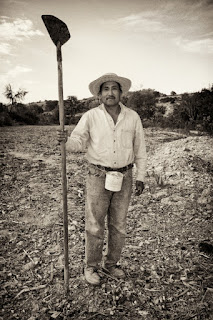 But as I straightened up and saw the others planting ahead of me in the furrows above, it struck me that this complex world faces two fundamental and critical challenges. One is to remold the lifestyle of the peoples of the global North to something that matches the ability of the planet to sustain us. The second is to work with the majority of humanity, which lives in the rural global South, to create economically healthy farming communities, where the world’s food needs can be met and where there is no longer the need to emigrate to unsustainable urban centers.
But as I straightened up and saw the others planting ahead of me in the furrows above, it struck me that this complex world faces two fundamental and critical challenges. One is to remold the lifestyle of the peoples of the global North to something that matches the ability of the planet to sustain us. The second is to work with the majority of humanity, which lives in the rural global South, to create economically healthy farming communities, where the world’s food needs can be met and where there is no longer the need to emigrate to unsustainable urban centers. It is because of this second challenge that over 350 indigenous campesino men, women and children gathered in our nearby district center last week to celebrate the first annual Indigenous Campesino Fair and the inauguration of the Casa de la Milpa Sostenible, House of the Sustainable Milpa, a small museum featuring indigenous knowledge and biodiversity as a basis for a sustainable future.
It is because of this second challenge that over 350 indigenous campesino men, women and children gathered in our nearby district center last week to celebrate the first annual Indigenous Campesino Fair and the inauguration of the Casa de la Milpa Sostenible, House of the Sustainable Milpa, a small museum featuring indigenous knowledge and biodiversity as a basis for a sustainable future. 
 Our Niño a Niño group, called Ñuú Xekuechi (“Community of Children” in the indigenous Mixtec language) from the village of La Providencia participated, with 20 children and teenagers attending the event, having obtained special permits to be absent from school. The Campesino (family farmer) Fair was set up in the central square of the town of Nochixtlán, with tables and booths around the entire area, each displaying the myriad varieties and colors of native corns – in reds, blues, blacks and purples, various shades of yellow, and white ---- corn varieties deriving from ancestors going back to centuries before Christ: corns which carry in their genes the toughness of drought resistance, adaptability to high and low altitudes, those which survive extremes of temperature or rain fall… all of which have been carefully improved by indigenous farmers to adapt as needed to local conditions. There were also beans in many colors and sizes, various types of squash seeds, local herbs, as well as local types of medicinal plants and seeds.
Our Niño a Niño group, called Ñuú Xekuechi (“Community of Children” in the indigenous Mixtec language) from the village of La Providencia participated, with 20 children and teenagers attending the event, having obtained special permits to be absent from school. The Campesino (family farmer) Fair was set up in the central square of the town of Nochixtlán, with tables and booths around the entire area, each displaying the myriad varieties and colors of native corns – in reds, blues, blacks and purples, various shades of yellow, and white ---- corn varieties deriving from ancestors going back to centuries before Christ: corns which carry in their genes the toughness of drought resistance, adaptability to high and low altitudes, those which survive extremes of temperature or rain fall… all of which have been carefully improved by indigenous farmers to adapt as needed to local conditions. There were also beans in many colors and sizes, various types of squash seeds, local herbs, as well as local types of medicinal plants and seeds.The House of the Milpa museum tells the story of the form of planting developed uniquely in Mesoamerica that one expert has called “perhaps one of the most successful inventions of humankind.” Planting corn, beans, squash, amaranth, tomatillo, together in the same plot and allowing the wild edible plants to grow among them yields high production of one of the healthiest diets on the planet and a soil treatment and weed and insect control which have made it sustainable for millennia. In some areas here the current version of the milpa has been improved with careful seed selection to the point that it has tripled production. The math is interesting: 60-70% of the world’s food is still produced by small farmers. Industrial agriculture, which accounts for the remaining production, can only expect a few percentage points of improvement in the future. Doubling or tripling the production of the 60-70% of small farmers has much greater potential for feeding the world than Archer Daniels Midland and its corporate cohorts.





No comments:
Post a Comment